Chapter 25: The Digestive System
1/173
Earn XP
Description and Tags
Merged flashcards from Chapter 25, McGraw Hill Anatomy and Physiology Tenth Edition, by Kenneth S. Saladin.
Name | Mastery | Learn | Test | Matching | Spaced |
|---|
No study sessions yet.
174 Terms
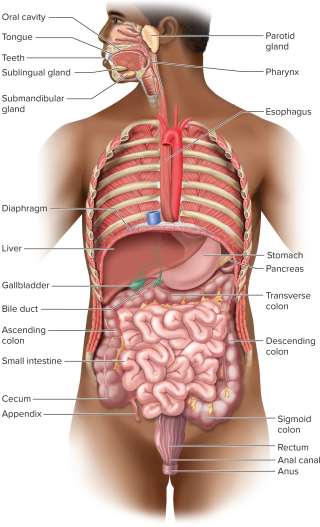
Digestive system
Organ system that processes food, extracts nutrients, and eliminates residue
Broken into ingestion, digestion, absorption, compaction, and defecation
Ingestion
The selective intake of food
Digestion
The mechanical and chemical breakdown of food into a form usable by the body
Absorption
The uptake of nutrients into the digestive tract to the blood and lymph
Compaction
The absorption of water and consolidation of indigestible residue into feces
Defecation
The elimination of feces
Mechanical digestion
The physical breakdown of food into smaller particles; done by the cutting of the teeth, churning of the stomach, and enzymatic action
Chemical digestion
The use of hydrolysis reactions by digestive enzymes to break down food; enzymes are created in salivary glands, stomach, pancreas, and small intestine
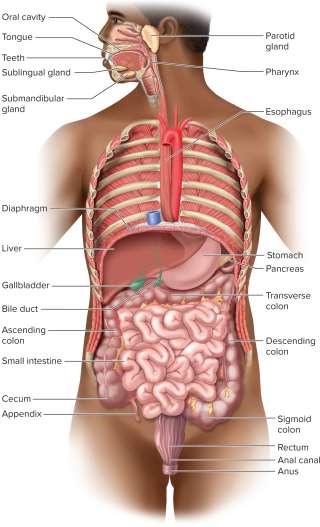
Digestive tract (alimentary canal)
The pathway from the mouth to the intestines
Digestive tract pathway
Mouth
Pharynx
Esophagus
Stomach
Small intestine
Large intestine
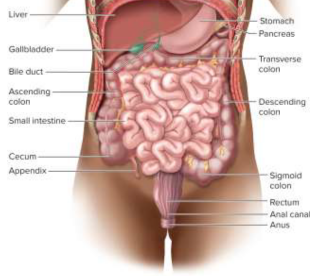
Gastrointestinal tract (GI tract)
The stomach and intestines
Accessory organs
Organs that aid in digestion, like the teeth, tongue, salivary glands, liver, gallbladder, and pancreas
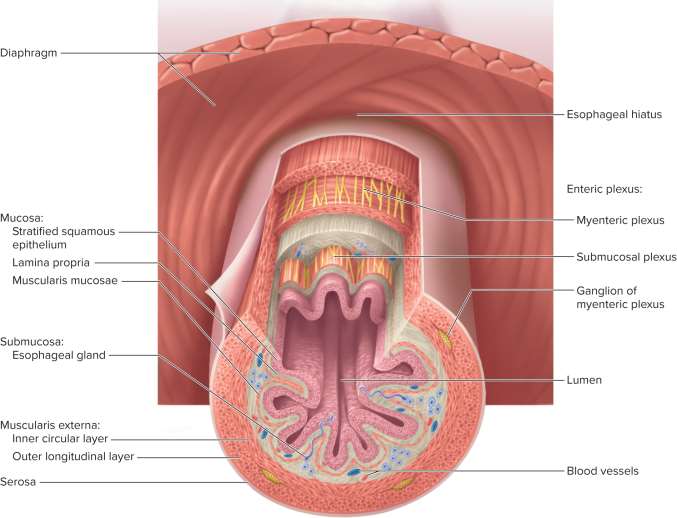
Digestive tract layers
Mucosa (for movement)
Submucosa
Musclaris externa (muscles)
Serosa (bindings)
Mucosa (mucous membrane)
The mucous lining of the digestive tract that aids movement and has mucosa-associated lymphatic tissue for immune responses
Mucosa-associated lymphatic tissue (MALT)
Lymphatic tissue on the mucosa to defend against pathogens in food
Submucosa
The thick layer of loose connective tissue below the mucosa; contains blood vessels, lymphatic vessels, nerve plexus, mucus-secreting glands, and some MALT
Muscularis externa
The layers of muscle in the digestive system that propel and push food and residue through the tract
Serosa
Layer of tissue that has some blood vessels and adventitia (binding fibrous connective tissue)
Adventitia
Binding fibrous connective tissue between the digestive tract and other organs
Enteric plexus
The nervous network within the digestive system that regulates digestive tract motion, secretion, and blood flow — mainly autonomic action
Submucosal plexus
Nerve system part of the enteric plexus within the submucosa; controls mucous and motility
Myenteric plexus
Nerve system part of the enteric plexus within the muscularis externa; controls contractions
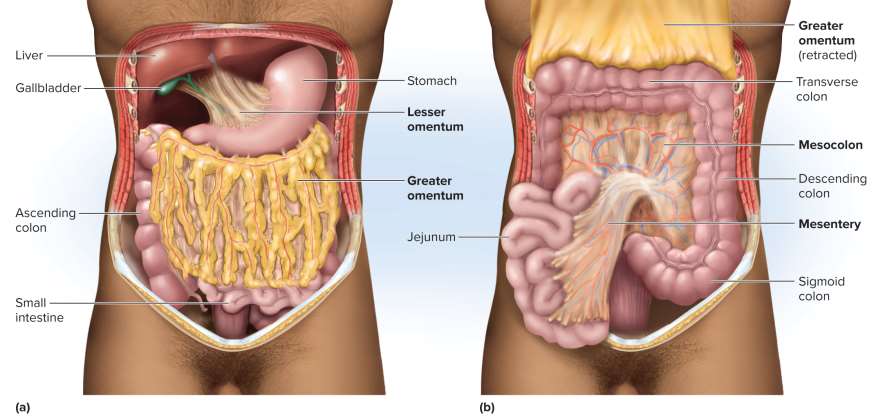
Mesentery
The connective tissue sheet that suspends the stomach and intestines from the abdominal wall to allow contractions and freedom of movement; has posterior and anterior sections

Lesser omentum
Ventral mesentery that extends from the lesser curvature of the stomach to the liver
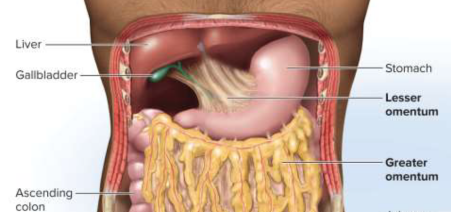
Greater omentum
Mesentery that hangs from the greater curvature of the stomach and covers the small intestine
Short reflexes (myenteric reflexes)
Stretch reflexes in the digestive tract for swallowing
Long reflexes (vagovagal reflexes)
Reflexes part of the parasympathetic stimulation for digestive motility and secretion
Gastrin and secretin
Two hormones secreted into the blood that stimulate distant parts of the digestive tract
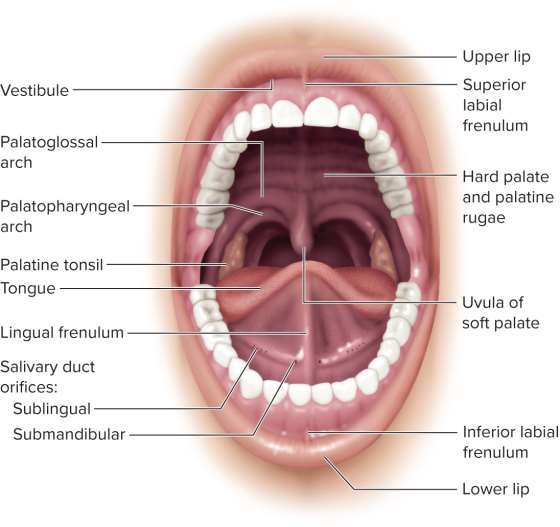
Oral cavity (buccal cavity)
The mouth
functions in ingestion, taste, digestion, swallowing, speech, and respiration
keratinized in areas subject to food abrasion, like the gums and hard palate
Cheeks and lips
Functions in food retention and oral control, speech, and sucking and blowing actions — closes exposure to outside
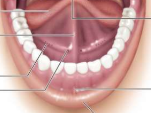
Frenulum
A type of tissue that attaches to the parts of the mouth; have superior and inferior labial (lip) types as well as one for the tongue (lingual)
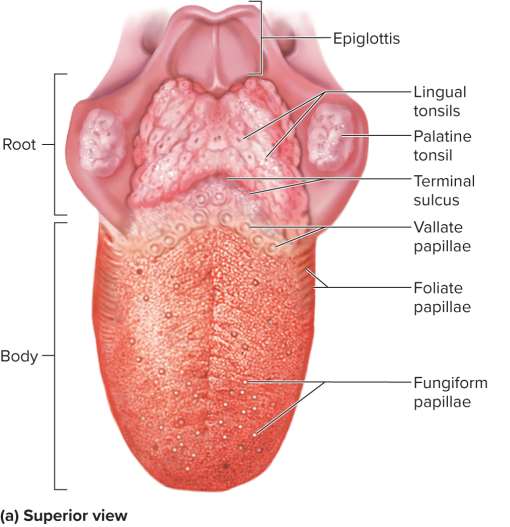
Tongue
A muscular, bulky, but agile and sensitive organ that functions in taste, texture, and speech with non-keratinized squamous epithelium
Lingual papillae
Bumps and projections that are the sites of most taste buds
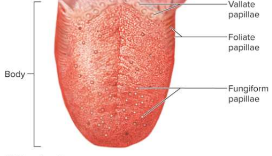
Body (of the tongue)
The anterior \frac{2}{3} of the tongue that occupies the oral cavity
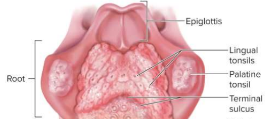
Root (of the tongue)
The posterior \frac{1}{3} of the tongue that occupies the oropharynx

Lingual tonsils
Tonsils contained in the root of the tongue; inflammation causes pain swallowing
Palate
Section of the mouth that separates the oral cavity from the nasal cavity, allowing breathing while chewing
Hard palate (bony palate)
Anterior portion of the palate supported by the maxillae and palatine bones
Soft palate
Posterior portion of the palate with a more spongy texture; features the skeletal muscle and glandular tissue as well as the uvula

Uvula
Projection visible at the rear of the mouth that helps food retention until ready to swallow
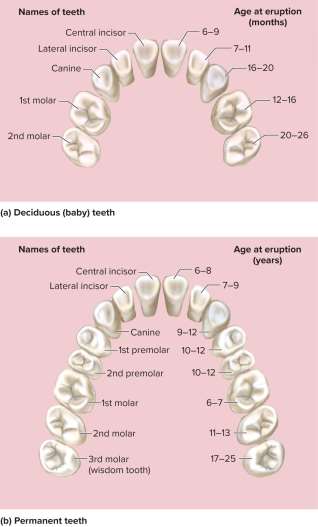
Dentitions
The teeth; they chew food into smaller pieces and expose more surface area for digestive enzyme action — 16 in the maxilla, 16 in the mandible for adults
Alveolus
The tooth socket in the bone where teeth are embedded
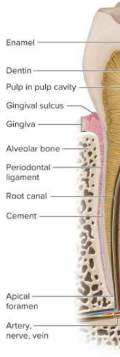
Periodontal ligament
Ligament whose collagen fibers penetrate into the bone on one side and into the tooth on the other for firm but slightly loose movement for chewing
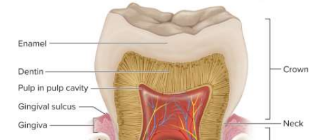
Gingiva (gum)
Tissue that covers the alveolar bone for tooth embedding; teeth defined by gingiva portions of crown, root, and neck
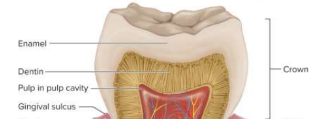
Crown
The portion of the tooth above the gum
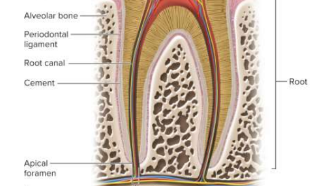
Root
The portion of the tooth below the gum in the alveolar bone
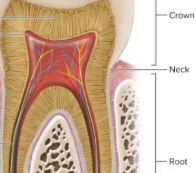
Neck
Point where the crown, root, and gum meet

Dentin
The hard yellowish tissue that makes up most of the tooth

Enamel
Noncellular secretion that cannot regenerate and covers the crown and neck of the tooth
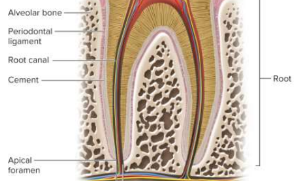
Cement
Covers the root of the tooth
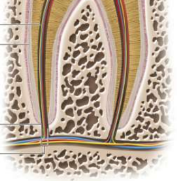
Root canal
The space in the root of the tooth leading to the pulp cavity in the crown; contains nerves and blood vessels
Eruption
The movement of teeth out of the gums as the develop; seen twice with infants and later permanent tooth replacement
Deciduous teeth
Early teeth that erupt from 6 to 30 months
Permanent teeth
Teeth that replace deciduous teeth between the ages of 6 and 25
Third molars (wisdom teeth)
Teeth that may erupt from 17 to 25 years, if at all — may be impacted or crowded so they cannot erupt
Plaque
A sticky residue on teeth made of bacteria and sugars due to the high count of microorganisms in the mouth — can dissolve enamel and dentin to form cavities
Root canal therapy
Treatment for cavities to remove the tooth to prevent further bacterial invasion
Mastication (chewing)
Process that breaks food down into smaller pieces to be swallowed and exposes more surface to digestive enzymes — starts with teeth and saliva
Saliva
Functions to moisten the mouth, begin some digestion, cleanse the teeth, inhibit bacterial growth, and dissolves food to stimulate taste buds
Salivary glands
Glands that secrete saliva at a constant rate
Pharynx
Muscular funnel that connects the oral cavity to the esophagus and nasal cavity to the larynx
Esophagus
The straight muscular tube 25 to 30 cm long between the pharynx and stomach to move food with some mucus
Lower esophageal sphincter (LES)
Sphincter at the inferior end of the esophagus to prevent stomach acid regurgitation that can damage the esophageal mucosa
Heartburn
Burning sensation produced by acid reflux into the esophagus
Deglutition (swallowing)
A complex action involving over 22 muscles in the mouth, pharynx, and esophagus to move food
Swallowing center
A pair of nuclei in the medulla oblongata that controls swallowing
Swallowing phases
Oral phase (voluntary to collect food)
Pharyngeal phase (involuntary to prevent choking)
Esophageal phase (involuntary to move food down)
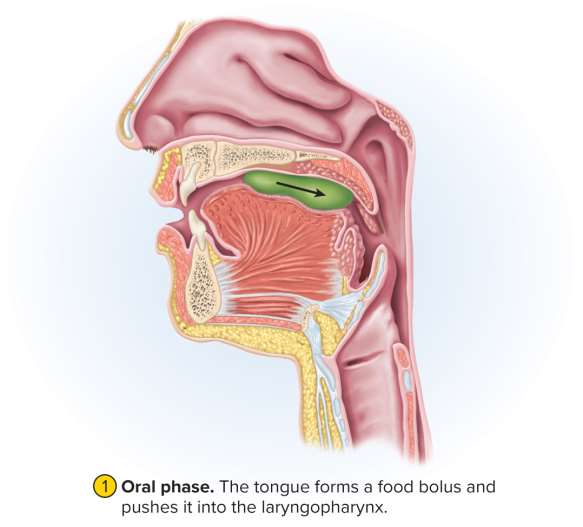
Oral phase
Voluntary swallowing phase; collects food with tongue to push it posteriorly as it accumulates
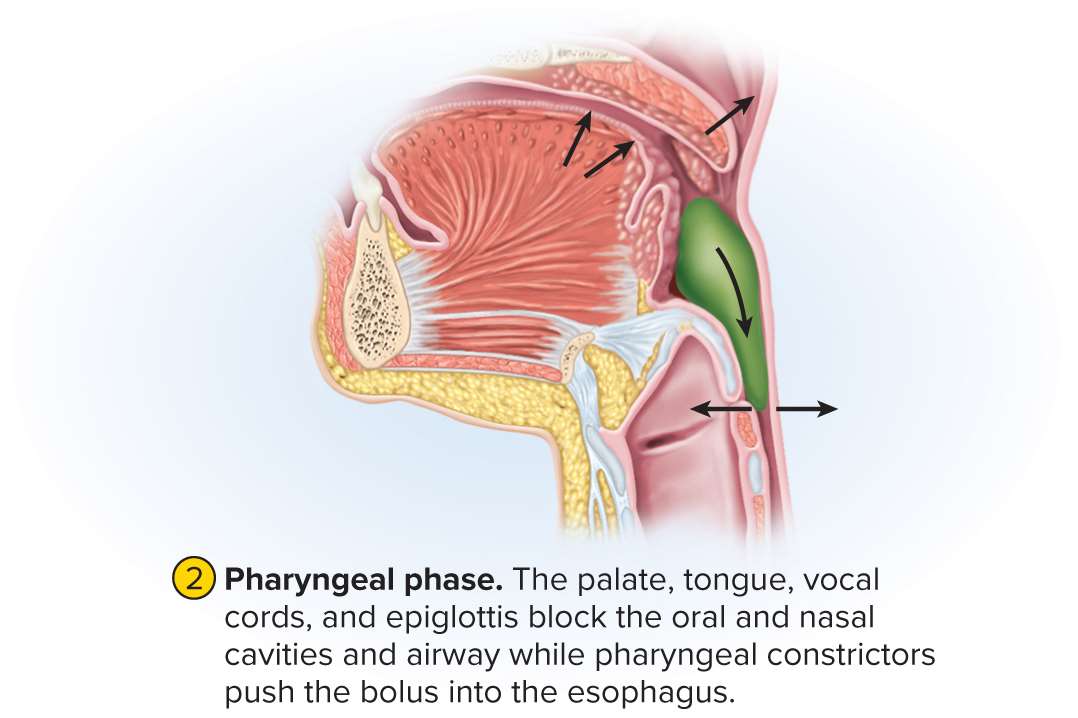
Pharyngeal phase
Involuntary swallowing phase; prevents food and drink from entering the mouth or nasal cavity and breathing is suspended as the airway is closed
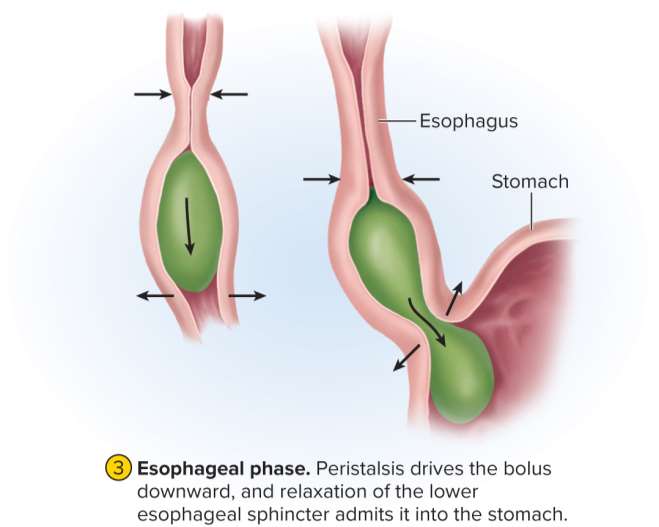
Esophageal phase
Involuntary swallowing phase with involuntary contractions (peristalsis) to move food through esophagus regardless of gravitational orientation
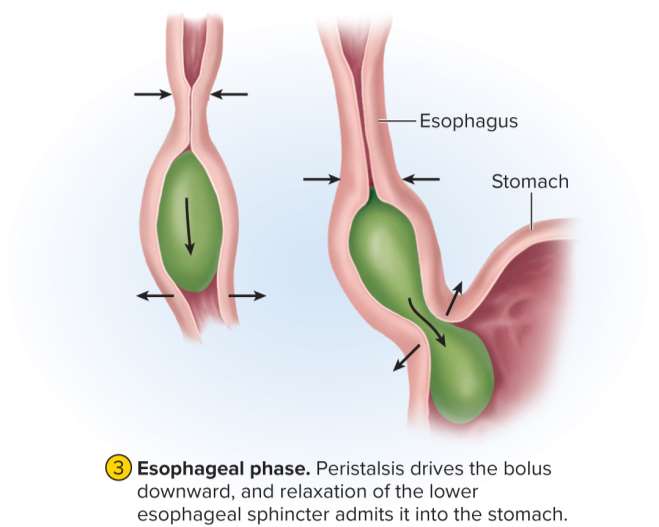
Peristalsis
Involuntary contractions that move food down the esophagus; is controlled by the swallowing center and leads the lower esophageal sphincter to relax
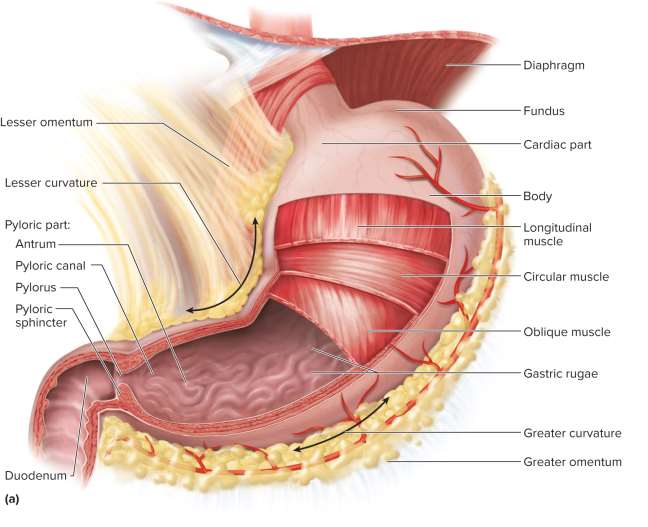
Stomach
A J-shaped, muscular sac in the upper left abdominal cavity that functions as a food storage organ for mechanical and chemical digestion
Chyme
The acidic, soupy mixture of semidigested food that passes on to the small intestine
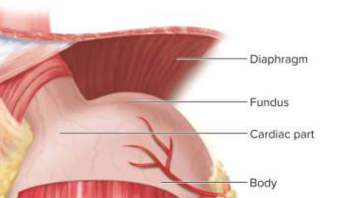
Cardiac part
A small area within about 3 cm of the cardiac orifice; connects esophagus to stomach
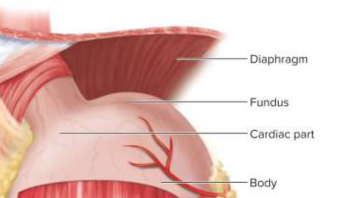
Fundic region (fundus)
Dome superior to the esophageal attachment
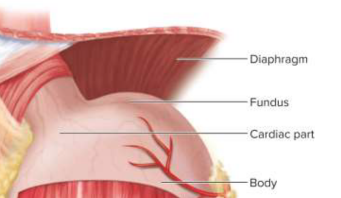
Body
The greatest part of the stomach distal to the cardiac orifice
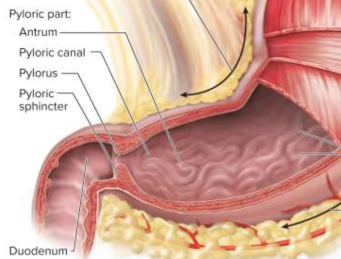
Pylorus
The narrow passage from the stomach to the duodenum
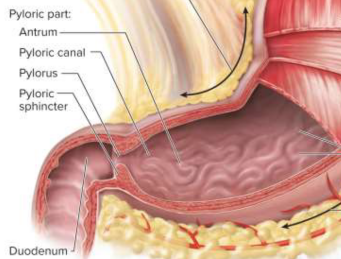
Pyloric sphincter
A ring of smooth muscle around the pylorus that regulates the passage of chyme into the duodenum
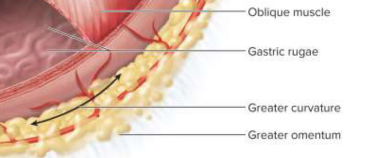
Greater curvature
40 cm curvature from which the greater omentum hangs
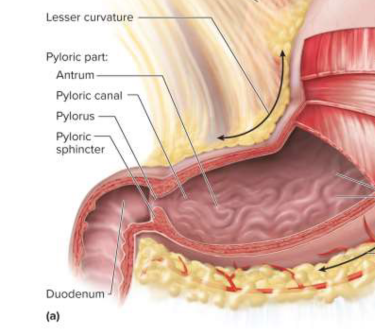
Lesser curvature
10 cm curvature from which the lesser omentum hangs

Gastric rugae
Longitudinal wrinkles that allow for expansion when full and contraction when empty
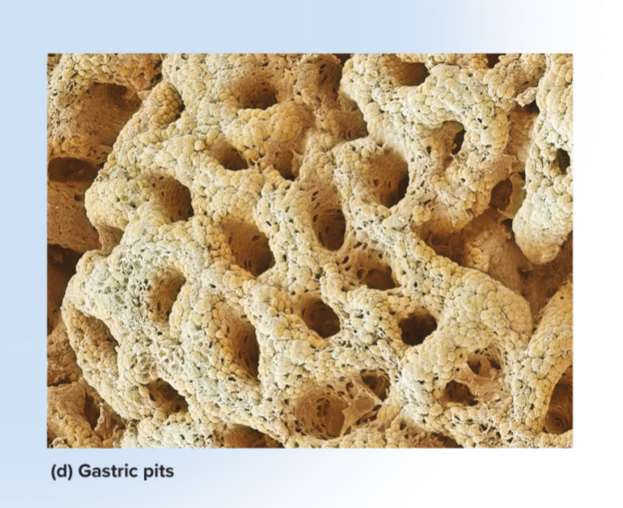
Gastric pits
Depressions in the gastric mucosa with two or three tubular glands at the bottom; secretes substances
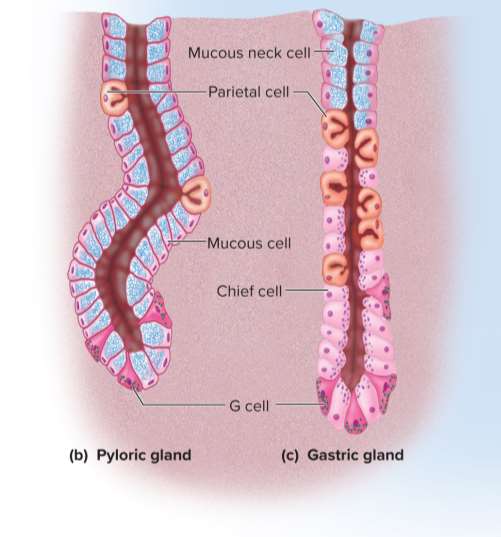
Mucous cells
Cells that secrete mucus in the cardiac and pyloric glands (called mucous neck cells in gastric glands due to their position)
Regenerative cells (stem cells)
Cells found in the base of the gastric pit and neck of the glands; divides rapidly and produces a continual supply of new cells for replenishment
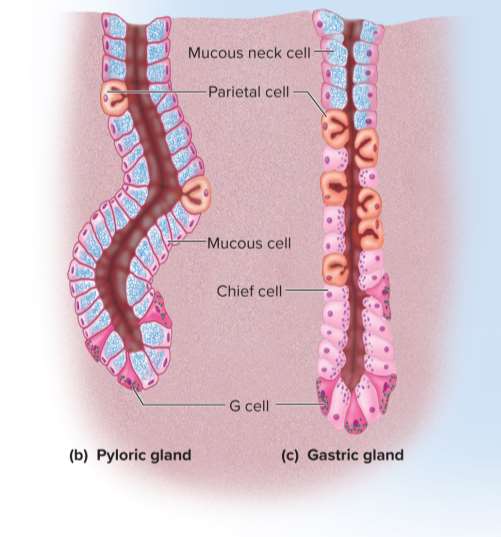
Parietal cells
Cells found mostly in the upper half of the glands; secretes hydrochloric acid, intrinsic factor, and a hunger hormone called ghrelin

Chief cells
The most numerous cell type in the stomach; secretes gastric lipase and pepsinogen in the gastric glands to dissolve lipids and proteins
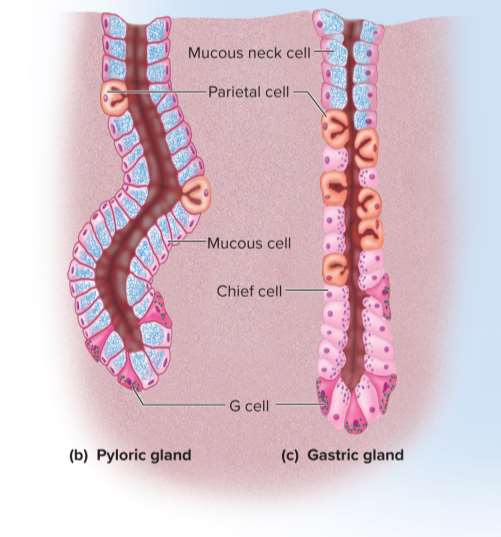
Enteroendocrine cells
Cells concentrated in the lower end of the glands that secrete hormones and messengers to regulate digestion
Gastric juice
The 2 to 3 liters of juice produced by the gastric glands per day; mainly a mixture of water, hydrochloric acid, and pepsin
Hydrochloric acid (HCl)
Acid that breaks up connective tissues and plant cell walls for liquification and chyme formation; also destroys pathogens
Pepsinogen
Enzyme that is secreted by chief cells to digest proteins
Gastric lipase
Enzyme that digests about 10 to 15% of dietary fats in the stomach (the rest is digested in the small intestine)
Intrinsic factor
Helps absorb vitamin B12 in the small intestine to later synthesize hemoglobin — secretion of this is the only indispensable function of the stomach
Swallowing center
Part of the medulla oblongata that signals the stomach to relax during swallowing; controls chyme flow to 3 mL for digestion and neutralization
4 to 6 hours
The typical time needed for the stomach to empty after a meal (higher fat contents extend time)
Vomiting
The forceful ejection of stomach and intestinal contents (chyme) from the mouth; can be caused by overstretching the stomach, alcohol or other irritants, trauma, or pain or sensory stimuli
Retching
Spasms of the chest and abdomen that dilate the esophagus before vomiting, often accompanied by tachycardia, salivation, and sweating, with chyme sometimes moving into the esophagus
Projectile vomiting
Sudden vomiting with no prior nausea or retching; common in feeding infants
Bulimia
An eating disorder with sometimes chronic, intentional vomiting; hydrochloric acid in vomit can cause tooth enamel erosion and respiratory tract destruction
Digestion
The chemical and mechanical breakdown of food; partially done by salivary and gastric enzymes but primarily done in the small intestine
Absorption
Obtaining nutrients or substances from food; not done by the stomach (except for some drugs like aspirin) and can be affected by capacity (as is with alcohol being more intoxicating with food)